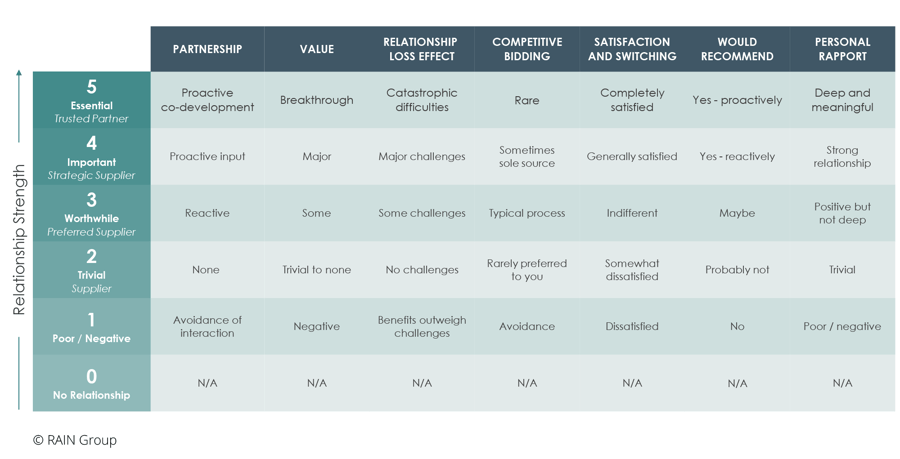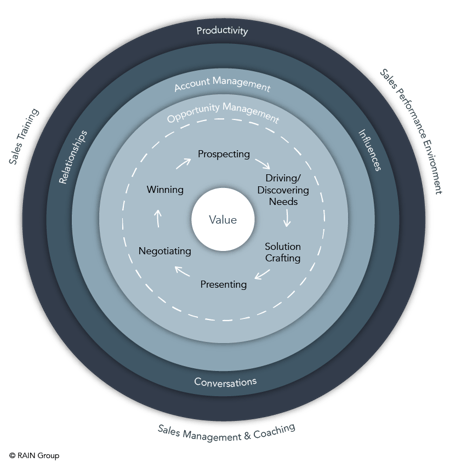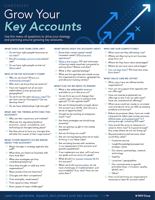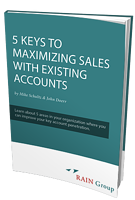Whether you call it cross-selling, upselling, or growing accounts, maximizing revenue from existing clients often represents an untapped revenue growth opportunity.
Acquiring a new customer can be significantly more expensive than retaining an existing one. Some studies and business analysts suggest that the cost of acquiring a new customer is five to seven times greater than retaining an existing one.1
Yet cross-selling, up-selling, and growing accounts are major challenges for many companies.
Tips and Best Practices for Cross-Selling
What Is Cross-Selling?
Cross-selling is the practice of selling additional products or services to an existing client. It’s about recognizing the needs of your clients and offering solutions that complement their primary, or initial, purchase.
For instance, if a company buys a CRM software solution, suggesting an added analytics module, add-on, or integration service is an example of cross-selling.
Benefits of Cross-Selling
Sales leaders cite increasing business with existing accounts as a top priority, according to RAIN Group’s research on Top-Performing Sales Organizations. This comes as no surprise when you learn that Top Performers are:
- 3.1x more likely to grow revenue by 20% or more in their strategic accounts
- 3.4x more likely to grow profit by 20% or more in their strategic accounts
- 4.5x more likely to experience year-over-year improvement in client satisfaction
The primary purpose and benefit of cross-selling is threefold:
- Deepen Client Relationships: By understanding and catering to the broader needs of clients, sellers can strengthen their bond with them, leading to increased loyalty and trust.
- Maximize Revenue: Selling to existing clients is often more cost-effective than acquiring new ones. Cross-selling leverages this by increasing the average customer value.
- Enhance Client Experience: When done right, cross-selling can enhance the client experience by providing solutions they hadn’t considered but find valuable.
What Is the Difference Between Cross-Selling and Upselling?
While both cross-selling and upselling aim to increase sales from existing clients, they differ in approach:
- Cross-Selling: Offering complementary products or services. For example, a seller might suggest a maintenance contract to a client buying manufacturing equipment or insurance solutions for financial services customers.
- Upselling: Encouraging clients to purchase a higher-end product than what they're considering. For instance, a seller might recommend an enterprise-level CMS solution that includes features for SEO, generative AI, website and email management, and customer service ticket handling over a basic package without these features.
5 Keys for Cross-Selling Success
The best sellers focus on five key areas to affect their cross-selling results:
1. Bring Value
The best sellers have a consistent process for expanding value. They recognize the value they provide and align it with what the buyer values most. They uncover buyers’ needs and drive demand for existing company offerings.
If buyers value you and your offerings, they’ll be more likely to continue buying from you after the initial purchase and be open to expanding your relationship.
For example, a software development company that provides a client with a custom application might recognize that the customer also needs cloud hosting services. By offering a bundled package or a discount on hosting, the company can provide added value for the client.
The best sellers also have a process for co-creating value with customers. They work collaboratively with clients to construct new ways of delivering value.
As you consider cross-selling, here are some questions to ask yourself to help understand the value you can offer to existing customers:
- What value have we offered similar organizations?
- How can we support their agenda with our offerings?
- Have we considered all our offerings?
- What value could we create or co-create beyond existing products or services?
- Beyond products or services, what would they value most (e.g., customer service, tech support, strategic insights, partnerships, etc.)?
As you approach cross-selling, you should know the value you provide, know what the customer values most, and create opportunities to connect the two.
2. Develop Strong Relationships
Building and deepening relationships yields strong results. View client relationships from a broad perspective and consider the entire client organization rather than just individual contacts.
Growing accounts requires:
- Strengthening and deepening existing relationships
- Establishing new relationships in other buying centers and at enterprise levels
- Viewing relationships from the perspective of your company with the client organization as a whole, as well as you, individually, with your client contact
Take the time to objectively assess where your relationships with existing clients fall on the Relationship Strength Meter.

For which of your clients are you a trusted partner? This represents the highest relationship level and, in truth, few are at this level. Instead, perhaps you’re at the supplier, preferred supplier, or strategic supplier level.
Once you’ve found the level of your client relationship, you can plan for what it'll take to get the relationship to the next level.
For instance, a B2B marketing agency that has provided SEO services to a client might strengthen its relationship by offering regular strategy sessions to the client’s marketing team, ensuring the client feels valued and has what they need to execute on the SEO recommendations.
This approach could potentially move the agency from preferred to strategic supplier. A strong relationship at this level means the client is likely to proactively seek your advice and solutions, see you as bringing major value to them, be less likely to switch to a competitor, and be more likely to recommend and refer you.
3. Assemble the Right Team
While cross-selling can be undertaken by individual sellers, effective account growth often requires a team approach. Sellers tend to know what they sell and sell what they know. In many organizations, product and service experts can help with cross-selling.
These six key roles include:
- Results Driver
- Relationship Lead
- Innovator
- Collaborator
- Technical Expert
- Project Manager
Each role plays a unique part in ensuring the account’s growth. The primary seller or an account manager may play several roles, and other team members can play multiple roles, as well.
Learn more about the six account management roles. >>
For example, an IT consultancy might have a Relationship Lead who maintains regular contact with the client, an Innovator who suggests new IT solutions based on the client’s evolving needs, and a Technical Expert who ensures that the solutions are feasible and beneficial.
4. Use an Account Management Process and Planning Tool
The best sellers understand the importance of a systematic process when it comes to growing accounts and use the necessary tools to support it.
One way to do this is by incorporating an account planning tool into your cross-selling and account growth process. This will help you make sure you understand areas such as:
- The current state of a client
- Trends affecting them
- The value you can add
- Your key competitors
- The people on your team and the client’s
- Specific growth opportunities
- An action plan for moving forward
Your account planning tool can be comprehensive like the one used in strategic account and key account management. It can also be a simple document, organized by category to capture information like the points above, created as part of your cross-selling process. It doesn’t need to be complicated. Just having this tool be part of your process will help you stay on track.
5. Develop Both Account Management Skills and Sales Skills
Both sets of skills are crucial for cross-selling success. Ideally, you’ll apply your selling skills and strong account management skills simultaneously.
When you have a foundation of consultative selling skills, you can build on them and refine your account management skills further. Top consultative sellers:
- Proactively bring new ideas and perspectives to buyers
- Lead incisive needs discovery conversations
- Collaborate with buyers on solutions
- Cultivate strong rapport and buyer relationships
If you're already doing all of these things with buyers, you're in a position to apply these skills to your account management process. In the same way that consultative sellers do their research and build value with every touch, so too do strong account managers identify key accounts, maintain client relationships, and create effective account plans.
Though there's overlap between these skillsets, it's critical to recognize how they differ. Sales is often a short-term process of capturing attention and converting it into business. Account management is a long-term process of building trust and designing strategy around an extended client relationship.
Top-Performing Sellers do both, as demonstrated by our research-validated sales competency model, which identifies areas where top performers excel.

Effective sales training can help you build these skills to grow revenue from new and existing clients.
Cross-Selling: All About Value
Cross-selling is about getting more value out of what you already have. By offering relevant value-based solutions and employing effective cross-selling strategies, you can boost your bottom line and enhance client satisfaction and loyalty.
Getting cross-selling right involves understanding your clients deeply, putting together the right team to serve them, and consistently executing on the process. It also means having both strong consultative selling and account management skills.
Cross-selling isn’t just a sales tactic; it’s an essential strategy for moving your business forward.
1. Bang, J., Dholakia, N., Hamel, L., & Shin, S. (2009). Customer Relationship Management and Knowledge Discovery in Database. , 1778-1786. https://doi.org/10.4018/978-1-60566-026-4.CH144.







